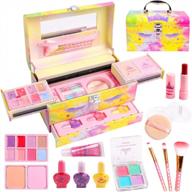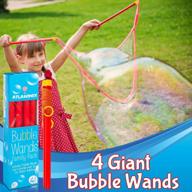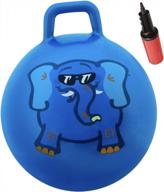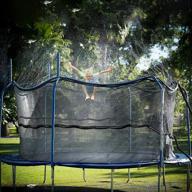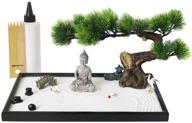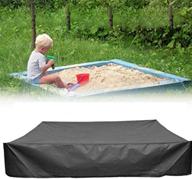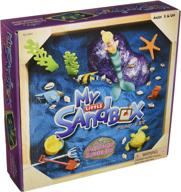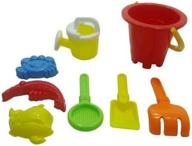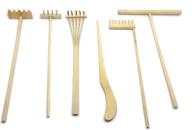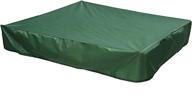Choosing the Right Sandbox
Selecting the ideal sandbox for your kids or grandkids requires some consideration of size, materials, portability and special features. This guide will help you decide which type of sandbox is right for your needs.
Size Considerations
Sandbox sizes generally range from a small 2 ft x 2 ft up to 8 ft x 8 ft or larger. Think about:
- Number of children - Bigger is better for multiple kids
- Available yard space - Make sure you have room for the footprint
- Child age/abilities - Bigger for older, more mobile kids
As a general guideline:
- 2 ft x 2 ft - Best for 1 younger toddler with parent
- 4 ft x 4 ft - Good for 1-2 kids around ages 2-5
- 6 ft x 6 ft - Accommodates more kids up to ages 6-8
- 8 ft x 8 ft - Ideal for multiple children and ages
Material Considerations
Sandboxes come in wood, plastic or metal materials. Compare:
| Material | Pros | Cons |
|---|---|---|
| Wood | Natural appearance, versatile | Prone to weathering, splintering |
| Plastic | Durable, low maintenance | Can get hot, fade over time |
| Metal | Very durable | Can get very hot, rigid sides |
Look for quality construction and materials ideal for your climate.
Portable or Stationary
Stationary sandboxes are permanently situated in your yard. Portable ones can be moved around.
Consider if you want to:
- Keep it in one spot vs. reposition
- Store away when not in use
- Take it with you (to grandma's, the park, etc.)
Portable sandboxes offer more flexibility but stationary versions tend to be bigger and more durable.
Special Features
Some sandboxes include extra features like:
- Built-in seats - For parents to supervise
- Covers - Protect contents when not in use
- Canopy - Provides shade from the sun
- Water table - For sensory water play
Think about which features would get the most use and provide the most play value.
By weighing all these factors, you can find the ideal sandbox for hours of creative, developmental outdoor fun!
Another interesting products
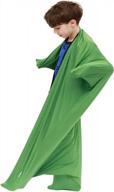

22 Review

Size Considerations for Choosing a Sandbox
One of the most important factors in selecting the right sandbox is determining the appropriate size for your needs. The ideal sandbox size depends on several practical considerations.
Number of Children
Think about how many kids will be using the sandbox at once. The general guidelines are:
- 2 ft x 2 ft - Good for 1 child under age 2 with parent supervision
- 4 ft x 4 ft - Accommodates 1-2 children ages 2-5 years
- 6 ft x 6 ft - Fits 2-4 kids ages 4-8 comfortably
- 8 ft x 8 ft - Provides ample play space for 4+ kids
Bigger is typically better, especially if multiple children will use the sandbox. However, also consider available yard space.
Yard Space
Make sure to measure the footprint of the sandbox you are considering and ensure you have adequate yard area. Allow for walkways on each side of the sandbox so kids can get in and out easily. Sandboxes are commonly available in these dimensions:
| Size | Footprint |
|---|---|
| 2 x 2 ft | 4 sq ft |
| 4 x 4 ft | 16 sq ft |
| 6 x 6 ft | 36 sq ft |
| 8 x 8 ft | 64 sq ft |
Make sure the sandbox footprint will work with your available yard area and landscaping.
Child Ages and Abilities
Also factor in the ages and ability levels of the children. For example:
- Younger toddlers need more supervision, so go smaller
- Preschoolers around ages 2-5 appreciate more space to dig and build
- Older kids ages 5-8 desire a very large area for elaborate creations
Bigger sandboxes allow more mobility and cooperative play among multiple children.
Shape Considerations
Sandboxes come in square, rectangular, hexagonal, octagonal and other shapes. Consider:
- Rectangles provide the most interior play space
- Squares are most common and economical
- Unique shapes like octagons fit nicely in corners
Prioritize plenty of interior play space, but select a shape that works best for your available yard area.
Determining the right size sandbox for your kids, yard and budget takes some planning. Following these guidelines will ensure an ideal sandbox for hours of enriching creative play.
Key Material Considerations for Sandboxes
Sandboxes are constructed from different materials, each with their own pros and cons. Evaluating the key differences in materials will help you select the right option for your climate and needs.
Wood
Wood is a classic natural material used for many sandbox frames and borders. Benefits of wood include:
- Attractive natural appearance
- Versatile - can stain, paint, or use as is
- Softer edges compared to metal or plastic
Potential downsides of wood include:
- Prone to weathering, splitting, splintering over time
- Requires more maintenance like sealing or repainting
- Not as durable as other materials
Plastic
Plastic sandboxes are growing in popularity. Plastic pros and cons:
- Tough, durable and low maintenance material
- Mold/mildew resistant
- Colorfast - resists fading from sun exposure
- Can become very hot in direct sunlight
- Less natural appearance compared to wood
Look for heavy duty plastic that won't become brittle or crack over time.
Metal
Metal sandboxes often feature galvanized steel or powder coated aluminum. Benefits include:
- Very strong, durable and long-lasting
- Withstands weather better than other materials
Potential metal disadvantages:
- Can get extremely hot in sun - burn risk
- Not as natural looking as wood
- Sides are rigid and flat rather than curved
Use caution with metal in direct sun or pair with a cover.
Comparison
Weigh the pros and cons of each primary material:
| Material | Durability | Weather Resistance | Appearance |
|---|---|---|---|
| Wood | Fair | Fair | Best |
| Plastic | Good | Best | Fair |
| Metal | Best | Good | Fair |
Regional Factors
Also consider your climate. For example:
- In wet, humid areas rot-resistant plastic or metal work best
- In very hot climates,choose plastic over hot metal
- In cold zones, plastic becomes brittle so select durable wood or metal
Selecting the right sandbox materials for your region, aesthetic tastes, and durability needs will maximize enjoyment and minimize upkeep.
Similar products
Sandbox Lids - To Have or Not to Have?
Sandbox lids are covers that go over the top of the sandbox when not in use. Should you get a lid for your sandbox? Here are some pros and cons to help decide.
Benefits of Lids
Reasons to consider getting a sandbox with a lid include:
- Keeps contents clean - Protects from windblown debris, leaves, dirt, etc.
- Reduces mess - Prevents sand from being tracked into house
- Keeps out animals - Stops cats from using as litter box
- Prevents hazard - Makes sandbox unusable when unsupervised
Lids allow you to maintain clean sand for a longer time between changes.
Drawbacks of Lids
Reasons some people skip the lid:
- Added cost - Lids range from $50-$150 extra
- Assembly required - Hooks, hinges, lifts need installing
- Heavy and bulky - Difficult for kids to open/close themselves
- Can blow off or break in weather if lightweight
Lids can also be a hassle to move every time you want to use the sandbox.
Lid Materials
Sandbox lids come in different materials with pros and cons:
| Material | Pros | Cons |
|---|---|---|
| Plastic | Lightweight, durable | Can retain heat, fade over time |
| Wood | Matches wood sandbox, natural look | Prone to weathering |
| Vinyl | Won't peel, crack or warp | Plastic appearance |
| Aluminum | Very durable | Costly, conducts heat |
Alternative Protection
Instead of a lid, you could also:
- Use a tarp secured with weights when not in use
- Get a weather-resistant fabric canopy
- Build a lean-to style roof off the side of a house/shed
This provides overhead coverage when needed versus a lid that must be constantly removed.
Key Considerations
Look at factors like your climate, budget, pets, and how often it will be used vs. covered when deciding on getting a sandbox with or without a lid.
Top products in 🏖️ Sandboxes
Portable vs Stationary Sandboxes
Sandboxes come in either portable designs that can be moved around, or stationary versions that stay fixed in one spot. What are the differences and which is better for your needs?
Portable Sandbox Benefits
Some advantages of portable sandboxes include:
- Mobility - Can take to different spots in yard
- Storage - Folds up or disassembles for off-season storage
- Travel - Take to the park, beach, grandma's house
- Smaller footprint - Good for limited space
Portable styles work well if you want flexibility in sandbox placement rather than a permanent fixture.
Stationary Sandbox Benefits
Some perks of stationary traditional sandboxes are:
- Bigger size - More play space for kids
- Durability - Sturdier construction
- Permanence - Integrated yard feature
- Custom design - Tailor shape and size
Stationary sandboxes are ideal if you have ample room and want an installed backyard fixture.
Sandbox Type Comparison
| Portable | Stationary | |
|---|---|---|
| Sizes | Smaller | Larger |
| Materials | Plastic, metal, fabric | Wood, plastic, metal |
| Shapes | Basic squares/rectangles | Custom shapes possible |
| Weather durable | Fair | Excellent |
Hybrid Option
Some sandbox designs try to offer the best of both worlds. For example:
- Plastic or metal frames that assemble/disassemble quickly
- Light enough to move but durable for regular use
- Vinyl covers that zip off for travel then replace
These allow you to semi-permanently install the sandbox but still move it occasionally if needed.
Key Questions
When choosing portable or stationary, consider:
- Will location need to change? How often?
- Is maximizing play space or compact storage more important?
- Does your climate require super durable construction?
- Do you want the sandbox integrated into yard or separate?
Answering these will help select the ideal portable or stationary sandbox for your kids.
How Amazon Prime Improves Your Sandbox Shopping Experience
Amazon Prime provides a number of benefits that can enhance your shopping experience when purchasing sandboxes and other outdoor play equipment. Here are some of the key advantages Prime members enjoy.
Free Two-Day Shipping
One of the biggest perks of Amazon Prime is free two-day shipping on most products. This means the sandbox and accessories you order will arrive quickly so your kids can start playing sooner.
Instead of waiting a week or more for standard shipping times, Prime members often get their sandbox delivered within just two business days. You can typically get sandbox orders faster without paying expedited shipping fees.
Free Release-Date Delivery
On products with high demand like new sandbox releases, Amazon Prime also offers free release-date delivery. This ensures your product ships on the exact day it is released.
By being a Prime member, you can get the newest sandbox model or accessories delivered on launch day before inventory sells out. Non-members often face delays or backorders.
Free Returns
Amazon Prime also makes returns easy by offering free return shipping. So if the sandbox doesn't meet expectations or needs to be exchanged, you can send it back at no extra cost.
The peace of mind of easy, free returns is very convenient if you experience any issues with assembly, defects, or deciding on the right size.
Access to Lightning Deals
As a Prime customer, you get early access to Amazon's Lightning Deals, which are limited-time discounts on various products. This allows you to score temporary savings on sandboxes, lids, covers, toys, and more.
Lightning Deals sell out fast, so Prime members get a head start to access these sandbox-related bargains.
Overall, an Amazon Prime membership provides plenty of logistic conveniences and savings when buying sandboxes or other outdoor playsets and accessories. The faster shipping, release-date delivery, easy returns, and exclusive deals make shopping for your sandbox even more efficient.
- Choosing the Right Sandbox
- Size Considerations
- Material Considerations
- Portable or Stationary
- Special Features
- Size Considerations for Choosing a Sandbox
- Number of Children
- Yard Space
- Child Ages and Abilities
- Shape Considerations
- Key Material Considerations for Sandboxes
- Wood
- Plastic
- Metal
- Comparison
- Regional Factors
- Sandbox Lids - To Have or Not to Have?
- Benefits of Lids
- Drawbacks of Lids
- Lid Materials
- Alternative Protection
- Key Considerations
- Portable vs Stationary Sandboxes
- Portable Sandbox Benefits
- Stationary Sandbox Benefits
- Sandbox Type Comparison
- Hybrid Option
- Key Questions
- How Amazon Prime Improves Your Sandbox Shopping Experience
- Free Two-Day Shipping
- Free Release-Date Delivery
- Free Returns
- Access to Lightning Deals






